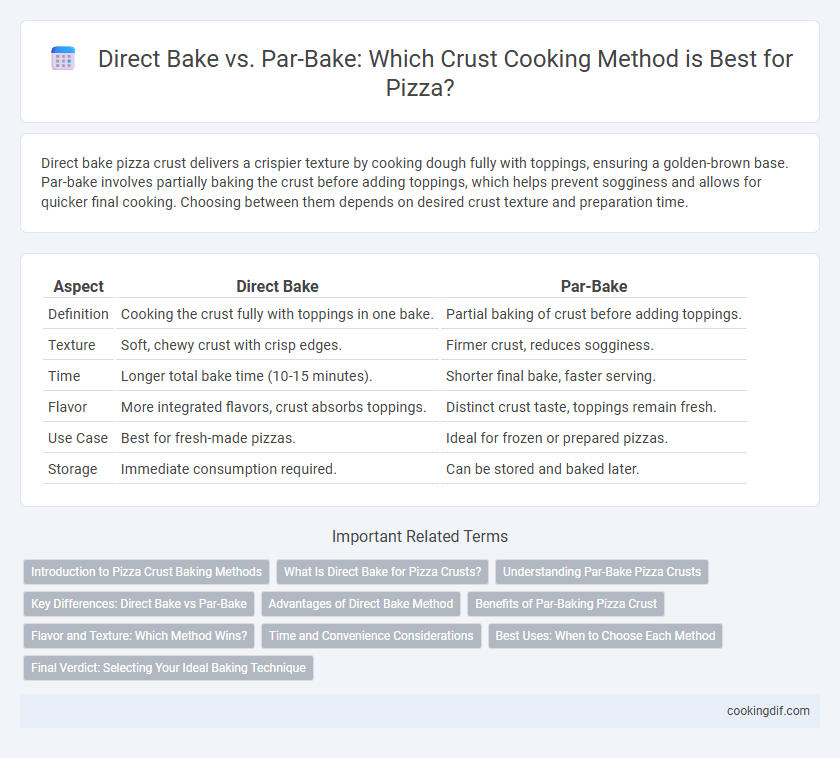Direct bake pizza crust delivers a crispier texture by cooking dough fully with toppings, ensuring a golden-brown base. Par-bake involves partially baking the crust before adding toppings, which helps prevent sogginess and allows for quicker final cooking. Choosing between them depends on desired crust texture and preparation time.
Table of Comparison
| Aspect | Direct Bake | Par-Bake |
|---|---|---|
| Definition | Cooking the crust fully with toppings in one bake. | Partial baking of crust before adding toppings. |
| Texture | Soft, chewy crust with crisp edges. | Firmer crust, reduces sogginess. |
| Time | Longer total bake time (10-15 minutes). | Shorter final bake, faster serving. |
| Flavor | More integrated flavors, crust absorbs toppings. | Distinct crust taste, toppings remain fresh. |
| Use Case | Best for fresh-made pizzas. | Ideal for frozen or prepared pizzas. |
| Storage | Immediate consumption required. | Can be stored and baked later. |
Introduction to Pizza Crust Baking Methods
Direct bake involves cooking the pizza crust fully in one step, resulting in a crispier and more evenly browned base, while par-bake partially cooks the crust before adding toppings, helping to prevent sogginess from moist ingredients. Par-baking is particularly effective for thick or stuffed crusts, ensuring a firm structure that holds toppings without becoming doughy. Both methods impact texture and cooking time, influencing the ultimate pizza quality based on crust type and desired outcome.
What Is Direct Bake for Pizza Crusts?
Direct bake for pizza crusts refers to baking the dough directly at high temperatures without any pre-baking steps, which results in a crispy, golden-brown crust with a chewy interior. This method allows the crust to fully cook alongside the toppings, creating a balanced texture and flavor. Direct baking is commonly used in traditional and wood-fired pizza ovens, enhancing the crust's crispness and preventing sogginess caused by wet toppings.
Understanding Par-Bake Pizza Crusts
Par-baking pizza crust involves partially baking the dough before adding toppings, which enhances crust texture by preventing sogginess and ensuring a crispier base. This technique allows for faster final baking times and a more even cook, as moisture from toppings doesn't soak into the dough. Par-baked crusts are widely used in commercial pizza production to maintain quality and consistency across various pizza styles.
Key Differences: Direct Bake vs Par-Bake
Direct bake involves cooking the pizza crust fully in the oven, resulting in a crisp texture and well-developed flavor throughout the crust. Par-bake partially cooks the crust before adding toppings, allowing for faster final baking and preventing sogginess while maintaining some dough softness. Key differences include baking time, texture, and preparation flexibility, with direct bake offering a robust crust and par-bake providing convenience for assembly and reheating.
Advantages of Direct Bake Method
The direct bake method for pizza crust cooking enhances flavor development through caramelization and Maillard reactions, resulting in a crispier, more textured crust. It simplifies the preparation process by eliminating the need for pre-baking, saving time and reducing energy consumption. This method also allows toppings to meld better with the crust during baking, improving overall taste and moisture balance.
Benefits of Par-Baking Pizza Crust
Par-baking pizza crust enhances texture by creating a firmer base that resists sogginess, ensuring a crisp, golden finish once toppings are added. This partial baking process shortens overall cook time and allows for better control over crust doneness, which is essential for restaurants and home cooks aiming for consistent results. Par-baked crusts also improve preparation efficiency, enabling quick assembly and serving without compromising flavor or quality.
Flavor and Texture: Which Method Wins?
Direct bake delivers a richer flavor and a crispier crust by cooking the dough fully with toppings, allowing caramelization and Maillard reactions to develop complex tastes. Par-bake partially cooks the crust first, resulting in a chewier texture with less browning and a milder flavor profile, often preferred for convenience and consistency. For optimal flavor and a perfect balance of crunch and tenderness, direct baking generally wins, especially in artisan and wood-fired pizzas.
Time and Convenience Considerations
Direct bake pizza crust requires longer in-oven time, typically around 10 to 15 minutes, ensuring a fully cooked and crispy base without additional reheating steps. Par-bake crusts are partially baked for about 4 to 6 minutes, allowing faster final assembly and cooking, making them highly convenient for quick meal prep and reducing overall wait time. Choosing between direct bake and par-bake depends on the balance between immediate crispiness and the convenience of pre-prepared crusts.
Best Uses: When to Choose Each Method
Direct bake crusts develop a crisp, golden exterior ideal for traditional pizzas with a moist topping, ensuring thorough cooking in a single step suitable for fresh dough and thick toppings. Par-bake crusts are partially baked to create a sturdy base before adding toppings, making them perfect for delicate or watery ingredients, frozen pizzas, and take-and-bake options that require reheating without sogginess. Choosing direct bake is best when time and simplicity matter, while par-bake suits scenarios needing crispness and texture retention after topping application.
Final Verdict: Selecting Your Ideal Baking Technique
Direct bake produces a crispier, evenly cooked crust with a well-developed flavor ideal for thin or traditional pizzas, while par-bake offers greater control by partially baking the crust to prevent sogginess before adding toppings. Par-baking is preferred for thicker or stuffed crusts to ensure thorough cooking without burning, but may result in a less robust texture compared to direct baking. Choose direct bake for bold, smoky textures and par-bake for precision and versatility depending on pizza style and ingredient moisture content.
Direct bake vs Par-bake for crust cooking Infographic

 cookingdif.com
cookingdif.com